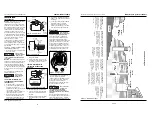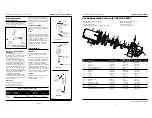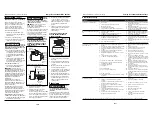
Para Piezas de Repuestos, Llame al 1-800-237-0987
Puede escribirnos a:
Wayne Water Systems
101 Production Drive
Harrison, OH 45030 U.S.A.
31 Sp
Manual de instrucciones de operación y piezas
Modelos para pozos profundos
1
Motor
32059-001
34142-001
34142-001
1
2
Tornillo
16636-002
16636-002
16636-002
4
3
Placa de sellado
4372-001
4372-001
4372-001
1
4
• Empaquetadura cuadrada de caucho para anillo
17150-001
17150-001
17150-001
1
5
• Ensamblaje de sello del eje
56393
56393
56393
1
6
Impulsor
23285-021
23285-022
23285-022
1
7
Difusor
17148-021
17148-021
17148-021
1
8
Tornillo
67007-001
67007-001
67007-001
2
9
• Anillo en o
15557
15557
15557
1
10
Venturi
17151-002
17151-003
17151-004
1
11
Boquilla
15672
15672
15672
1
12
19,1 mm (3/4”) Tapón de cebado
15921
15921
15921
1
13
Voluta
56869-001
56869-001
56869-001
1
14
6,4 mm (1/4”) NPT Tapón de cebado
16314-002
16314-002
16314-002
1
15
3,2 mm (1/8”) NPT Tapón de cebado
15766-002
15766-002
15766-002
1
17
Base
23029-021
23029-021
23029-021
1
19
Presostato 30010-021
30010-021
30010-021
1
•
Juego para reparaciones (Incluyes #4, 5 y 9)
56874-001
56874-001
56874-001
1
No. de
Para Los Modelos
Ref.
Descripción
SWS50-1/2 HP
SWS75-3/4 HP
SWS100-1 HP
Ctd.
17
1
2
3
4
5
6
7
8
11
12
10
13
14
16
9
15
Sírvase proporcionar la suguiente información:
- Número de modelo
- Número de serie (si tiene)
- Descripción y número de repuesto como se muestra
en la lista de repuestos
General Safety
Information
(Continued)
16. Do not attempt repairs to the electric
motor. All repairs to the motor must
be completed at a licensed or certified
electrical motor repair shop.
Do not touch an
operating motor.
Modern motors are designed to operate at
high temperatures.
17. Avoid kinking electrical cord and
protect from sharp objects, hot
surfaces, oil and chemicals. Replace
or repair damaged or worn cords
immediately.
Disconnect power
and release all
pressure from the system before
attempting to install, service, relocate or
perform any maintenance. Lock the
power disconnect in the open position.
Tag the power disconnect to prevent
unexpected application of power.
18. Keep fingers and foreign objects
away from ventilation and other
openings. Do not insert any objects
into the motor.
Risk of electric
shock! Never
connect the green (or green and yellow
wire) to a live terminal!
19. To reduce the risk of electrical
shock, the pump should be plugged
directly into a properly installed and
grounded 3-prong grounding type
receptacle, as shown in Figure 1.
The green (or green and yellow)
conductor in the cord is the
grounding wire. The motor must be
securely and adequately grounded
for protection against shock.
20. Where a 2-prong is encountered,
replace the plug with a properly
grounded 3-prong receptacle in
accordance with the National
Electrical Code, local codes and
ordinances. To ensure a proper
ground, the grounding means must
be tested by a licensed or certified
electrician.
!
WARNING
!
WARNING
!
WARNING
21. Use only 3-wire extension cords that
have a 3-prong, grounding type
plug, and 3-pole receptacles that
accept the equipment plug.
22. Use wire of adequate size to
minimize voltage drop at the motor.
Do not handle
pump or pump
motor with wet hands, when standing
on a wet or damp surface or when
standing in water. Fatal electrical
shock could occur.
Pump motor is
equipped with an
automatic resetting thermal protector and
may restart unexpectedly. Protector
tripping is an indication of motor
overloading because of operating pump
at low heads (low discharge restriction),
excessively high or low voltage,
inadequate wiring, incorrect motor
connections or defective motor or pump.
Pre-Installation
WATER SUPPLIES
The water supplies illustrated in Figure
12 are possible sources for water.
These water supplies can be divided
into two categories:
SURFACE WATER
Water from a lake, stream, pond and
cistern. This water is usually not fit for
human consumption, but may be
suitable for washing, irrigation or other
household uses.
GROUND WATER
Water found in the water bearing
stratum at various levels beneath the
earth. Of all the fresh water found on
earth only 3 percent is found on the
surface and 97 percent is underground.
TANKS - CONVENTIONAL STORAGE
The function of the tank is to store a
quantity of water under pressure.
When full, the tank contains
approximately 2/3 water and 1/3
!
WARNING
!
DANGER
2
Operating Instructions and Parts Manual
compressed air. The compressed air
forces the water out of the tank when
a faucet is opened. An air volume
control automatically replaces air lost
or absorbed into the water. The usable
water, or drawdown capacity, of the
tank is approximately 1/6 of the tanks
total volume when operated on a “20-
40” pressure setting (Figure 2).
TANKS - PRECHARGED STORAGE
A precharged storage tank has a
flexible bladder or diaphragm that acts
as a barrier between the compressed
air and water. This barrier prevents the
air from being absorbed into the water
and allows the water to be acted on by
compressed air at initially higher than
atmospheric pressures (precharged).
More usable water is provided than
with a conventional type tank.
Precharged tanks are specified in terms
of a conventional tank. For example, a
20 gallon precharged tank will have
the same usable water or drawdown
capacity as a 40 gallon conventional
tank, but the tank is smaller in size
(Figure 2).
PRESSURE SWITCH
The pressure switch provides for
automatic operation. The pump starts
when pressure drops to a cut-in setting.
Shallow Well Jet Pump
Air Volume
Control
Type
Required
Well X
Precharged
No
PCA
Precharged
No
12P & 30P Horizontal
Conventional
Yes
FX Horizontal
Precharged
No
CHART 1 - JET PUMP/TANK ASSEMBLIES
Air Volume
Control
Bladder
Conventional
Tank
Precharged
Tank
Figure 2 - Conventional & Precharged
Storage Tanks
TEST
RESET
Grounded
Pin
Grounded Outlet
Figure 1
www.waynewatersystems.com


































